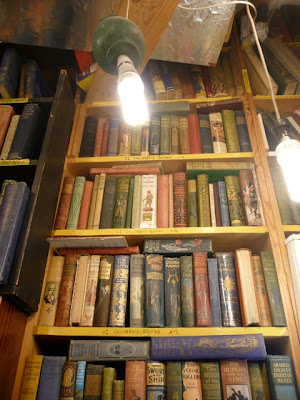I bought the following at a second hand book shop in Edinburgh. I was there to visit a National Trust site for a job, and had some time left over, so thinking I might find some interesting clothes or shoes I found myself being scared of the boutiques and blowing money in a book shop instead, coming home in the same pair of tragic old shoes (again).
This is the shop.

And here's what I bought.

The first I picked up in the £1 box outside the shop. I hovered for a bit as I thought no-one was in, and spent a good five minutes working out how to get the coin into the shop without breaking in. Since I've been thinking about doing some repeat-pattern covers for a bit (not for a publisher, just as a project) this one appealed, since the artwork was produced the same way, all drawn by hand. I've no idea what the book's like, but my Mum reckoned it'd be a rip-roaring story of the sea.

The second had a foiled and embossed cream cover which I got excited about. My friends Steve and Roger run a place in Leicester which does this sort of thing, and it was good to be reminded of the skills at my disposal in the local vicinity.

Then I went inside, since the door opened as I was trying to cram my pound coin under it. Here's the sight that greeted me:

I nearly fainted.


Here's the next one I bought. This one I picked up initially because the spine told me it was by 'Coleman', but with the discovery of a still-sparkling gold spine and that it was about butterflies, which I tend to draw quite a lot, it was sold. It's about 6" x 4", and is indeed written by one of my ancestors (I like to think).


Just look at these beautiful illustrations of butterflies. Some of them have a silver ink on them which still gleams in places.


The only downside is this page...

On the way to my most devastating unplanned purchase, I saw these 'Bibelots' which were massively desirable, but £200 EACH. Oof.

So then I saw this. I pulled it a bit too eagerly from the shelf on sight of the word 'Detmold', which caused the assistant to lower his trendy glasses a bit in my direction.

Charles Maurice and Edward Julius Detmold were prodigious illustrator twins born in 1883. Their output was large and impressive, working on pieces together, and were well on their way to joint and individual success when Maurice committed suicide without explanation in 1908. He was 24. Although distraught, his brother Edward lived and worked until the 1950s, and it is he who illustrated this book. Since they are among that fairy-lit collection of illustrators credited with creating the magical era of illustration around the turn of the century (Arthur Rackham, Kay Nielsen, Edmund Dulac and Aubrey Beardsley among them) I had to bring it home.

It's a first edition and is embossed with accurate line drawings of insects, with this debossed beauty on the back. Around 10"x8", and two inches thick, it's surprisingly light for its size largely, I think, down to the very fluffy paper inside which is easily damaged. It's like thick blotting paper. The type is set with a massive margin around it - this was a luxury book certainly - in something like Bodoni - I'm sure a type geek would soon tell me - and each colour plate is covered with rustly tissue paper.

Italian Locust. Great legs:

Common Wasp. Check the deboss around the plate:

Clock the attitude of the Preying Mantis here, the wary eyeball. Note not a hint of caricature, yet he imbues the fella with a personality of his own.

Finally the text itself is a delight. Fabre writes about every insect as a 'he' or a 'she', like this example from 'The Capricorn', which resonated with me immediately.
'Though the Capricorn-grub possesses these useless legs, the germs of future limbs, there is no sign of the eyes with which the fully-developed insect will be richly gifted. The larva has not the least trace of any organs of sight. What would it do with sight, in the murky thickness of a tree trunk?
But at the end of Spring the Capricorn, now in possession of his full strength, dreams of the joys of the sun, of the festivals of light. He wants to get out'.
Don't we all, little grub-face. We all want to get out into the sun and collect beautiful things like this. You don't find words and pictures like that in the DK Guide to Insects now, do you?

3 comments:
These books are amazing. What a treasure trove you have in that collection!
They look amazing! I bet they smell good too, all.... old-booky.
Beautiful finds!
Post a Comment